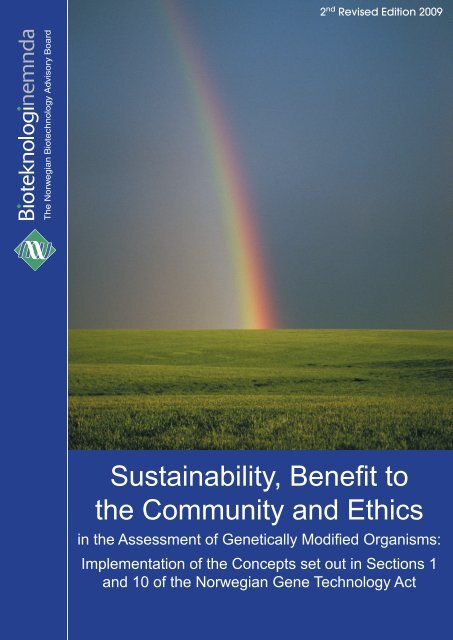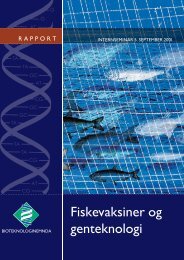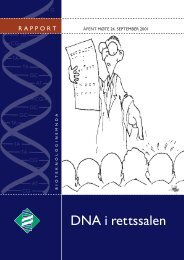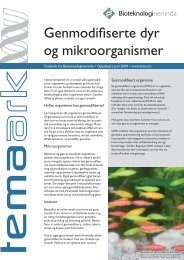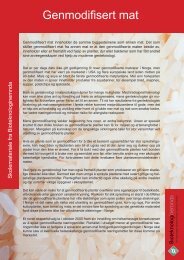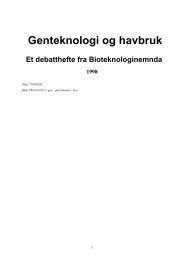Sustainability, Benefit to the Community and Ethics
Sustainability, Benefit to the Community and Ethics
Sustainability, Benefit to the Community and Ethics
- No tags were found...
Create successful ePaper yourself
Turn your PDF publications into a flip-book with our unique Google optimized e-Paper software.
The Norwegian Biotechnology Advisory BoardContentsIntroduction 5Opinion of <strong>the</strong> Biotechnology Advisory Board 71. Decision-making structure 72. System limits 73. Danger of detrimental effects on health <strong>and</strong> <strong>the</strong> environment 84. Precautionary principle 105. Sustainable development 136. <strong>Benefit</strong> <strong>to</strong> <strong>the</strong> community 157. O<strong>the</strong>r ethical <strong>and</strong> social considerations 17
<strong>Sustainability</strong>, <strong>Benefit</strong> <strong>to</strong> <strong>the</strong> <strong>Community</strong> <strong>and</strong> <strong>Ethics</strong> in <strong>the</strong> Assessment of Genetically Modified OrganismsIntroductionThe Norwegian Act relating <strong>to</strong> <strong>the</strong>production <strong>and</strong> use of genetically modifiedorganisms 1strongly emphasizes that <strong>the</strong>deliberate release of such organisms shouldhave no detrimental effects on ei<strong>the</strong>r healthor <strong>the</strong> environment. This emphasis is fullyin line with <strong>the</strong> legislation of o<strong>the</strong>r nationsconcerning <strong>the</strong> regulation of geneticallymodified organisms (GMOs). In <strong>the</strong> Act’sprepara<strong>to</strong>ry work 2 , several references aremade <strong>to</strong> <strong>the</strong> concept of risk. One of <strong>the</strong>sereferences emphasizes that <strong>the</strong> wording“without detrimental effects on health <strong>and</strong><strong>the</strong> environment” in <strong>the</strong> purpose statemen<strong>to</strong>f <strong>the</strong> Act should not be interpretedThe Gene Technology Act,Section 10, excerpt:“The deliberate release of geneticallymodified organisms may only beapproved when <strong>the</strong>re is no risk of adverseeffects on health or <strong>the</strong> environment.In deciding whe<strong>the</strong>r or not <strong>to</strong> grant anapplication, considerable weight shallalso be given <strong>to</strong> whe<strong>the</strong>r <strong>the</strong> deliberaterelease will be of benefit <strong>to</strong> society<strong>and</strong> is likely <strong>to</strong> promote sustainabledevelopment.”Sustainable developmentThe World Commission definedsustainable development in <strong>the</strong> report“Our Common Future” (1987) as“development that meets <strong>the</strong> needs of<strong>the</strong> present without compromising <strong>the</strong>ability of future generations <strong>to</strong> meet<strong>the</strong>ir own needs”.The concept of “sustainable development”is included in <strong>the</strong> Gene Technology Actin two ways, both as part of <strong>the</strong> purposestatement of <strong>the</strong> Act <strong>and</strong> as an explicitcriteria for approval (Section 10, secondparagraph, see above).literally – but ra<strong>the</strong>r that <strong>the</strong> expression“without detrimental effects” has beenused <strong>to</strong> emphasize <strong>the</strong> aim of carrying outa prior assessment of <strong>the</strong> risk <strong>to</strong> health<strong>and</strong> <strong>the</strong> environment <strong>and</strong> avoiding possibledetrimental effects, <strong>and</strong> that this should beunderpinned by <strong>the</strong> precautionary principle.It is fur<strong>the</strong>r stated that “a strict assessmen<strong>to</strong>f risk <strong>to</strong> health <strong>and</strong> <strong>the</strong> environment is inline with <strong>the</strong> views of <strong>the</strong> Government <strong>and</strong><strong>the</strong> Parliament 3 ” (These concepts will bediscussed fur<strong>the</strong>r in Chapter 3).As distinct from <strong>the</strong> regulations of o<strong>the</strong>rnations, however, <strong>the</strong> Norwegian GeneTechnology Act also stresses that <strong>the</strong>deliberate release of such organisms shouldrepresent a “benefit <strong>to</strong> <strong>the</strong> community” <strong>and</strong>enable “sustainable development”. Theseconcepts are used in Sections 1 <strong>and</strong> 10 of <strong>the</strong>Norwegian Gene Technology Act.The EU has since established new GMOdirectives4 that move <strong>to</strong>wards <strong>the</strong> Norwegianlegislation. However, <strong>the</strong>re are still differencesin <strong>the</strong> emphasis on ethics <strong>and</strong> benefit <strong>to</strong> <strong>the</strong>community as <strong>the</strong> Norwegian laws dem<strong>and</strong>an assessment of <strong>the</strong> GMO’s contribution <strong>to</strong>sustainable development.However, it is not self-evident how“sustainability” <strong>and</strong> “benefit <strong>to</strong> <strong>the</strong>community” should be considered in termsof <strong>the</strong> practical application of <strong>the</strong> Act. In <strong>the</strong>light of <strong>the</strong> prepara<strong>to</strong>ry work, consultativestatements <strong>and</strong> <strong>the</strong> political debate on<strong>the</strong> Gene Technology Act, it is not clearwhe<strong>the</strong>r <strong>the</strong> provisions contained in Section10 relating <strong>to</strong> “benefit <strong>to</strong> <strong>the</strong> community”<strong>and</strong> “sustainable development” are <strong>to</strong> beconsidered as additional requirements oras a softening-up of <strong>the</strong> requirement for nodetrimental effects on ei<strong>the</strong>r health or <strong>the</strong>environment. “Sustainable development” <strong>and</strong>“benefit <strong>to</strong> <strong>the</strong> community” can be unders<strong>to</strong>odas ei<strong>the</strong>r:1. For <strong>the</strong> Gene Technology Act, see www.lovdata.no2. Ot. prp. nr.8 (1992-93)3. S<strong>to</strong>rtinget: The Norwegian Parliament4. Most importantly <strong>the</strong> deliberate release directive 2001/18/ECwhich in 2002 replaced directive 90/2205
<strong>Sustainability</strong>, <strong>Benefit</strong> <strong>to</strong> <strong>the</strong> <strong>Community</strong> <strong>and</strong> <strong>Ethics</strong> in <strong>the</strong> Assessment of Genetically Modified OrganismsOpinion of <strong>the</strong> Norwegian Biotechnology Advisory Board1. Decision-making structureIn <strong>the</strong> opinion of <strong>the</strong> Norwegian BiotechnologyAdvisory Board, Section 10 of <strong>the</strong> GeneTechnology Act should be interpreted <strong>to</strong>mean that <strong>the</strong> requirements of “sustainabledevelopment”, “benefit <strong>to</strong> <strong>the</strong> community”<strong>and</strong> o<strong>the</strong>r “ethical <strong>and</strong> social considerations”represent prerequisites that alone couldcarry decisive weight against granting anapplication, but that should also be consideredin relation <strong>to</strong>, <strong>and</strong> weighed against <strong>the</strong> risk ofdetrimental effects, when such risk is low.Hence, an assessment of <strong>the</strong> individualapplication will have <strong>the</strong> following structure:1) Danger of detrimental effects on health<strong>and</strong> <strong>the</strong> environment:a) what are <strong>the</strong> possible negativeconsequences?b) what is <strong>the</strong> likelihood of suchconsequences occurring?2) The precautionary principle:a) is <strong>the</strong> risk assessment associatedwith justified uncertainty?b) is <strong>the</strong>re a possibility of substantialor irreversible harm?3) Is it:a) in compliance with <strong>the</strong> principle of“sustainable development”?b) of “benefit <strong>to</strong> <strong>the</strong> community”?c) “ethically <strong>and</strong> socially justifiable”?If <strong>the</strong>re is a demonstrable yet minor risk ofdetrimental effects under item 1) <strong>and</strong> <strong>the</strong>precautionary principle is not applicableaccording <strong>to</strong> item 2), <strong>the</strong>n <strong>the</strong> contribution<strong>to</strong> “sustainable development” <strong>and</strong> “benefit <strong>to</strong><strong>the</strong> community” may be seen as significantenough <strong>to</strong> warrant that <strong>the</strong> applicationnever<strong>the</strong>less may be recommended (<strong>the</strong>application is in o<strong>the</strong>r respects ethically <strong>and</strong>socially defendable).The Biotechnology Advisory Board is anadvisory body <strong>and</strong> should in all cases consider“sustainable development”, “benefit <strong>to</strong> <strong>the</strong>community” <strong>and</strong> o<strong>the</strong>r “ethical <strong>and</strong> socialconsiderations”, even though it believes <strong>the</strong>remay be a serious risk of detrimental effectsinvolved. In <strong>the</strong> event that <strong>the</strong> opinions of <strong>the</strong>decision-making authority, <strong>the</strong> Ministry of<strong>the</strong> Environment, were <strong>to</strong> differ from that of<strong>the</strong> Biotechnology Advisory Board on <strong>the</strong> riskof <strong>the</strong> detrimental effects of an application,it is important that assessments of <strong>the</strong> o<strong>the</strong>rcriteria stipulated in <strong>the</strong> Act should be made.2. System limitsAn essential question is <strong>to</strong> underst<strong>and</strong><strong>the</strong> limits of <strong>the</strong> system relating <strong>to</strong> <strong>the</strong>cases for consideration. It is particularlyimportant not <strong>to</strong> define <strong>the</strong> system limits for“sustainable development”, “benefit <strong>to</strong> <strong>the</strong>community” <strong>and</strong> o<strong>the</strong>r “ethical <strong>and</strong> socialconsiderations” <strong>to</strong>o narrowly. The GeneTechnology Act uses <strong>the</strong> terms “production”<strong>and</strong> “use” <strong>to</strong> express this broader approach.This means that assessments should no<strong>to</strong>nly apply <strong>to</strong> <strong>the</strong> genetically modifiedproduct itself, but also <strong>to</strong> <strong>the</strong> productionsystem in a broader sense, which includes<strong>the</strong> production line – from development <strong>and</strong>pilot production <strong>to</strong> processing in a productionfacility – <strong>and</strong> <strong>the</strong>reafter <strong>the</strong> marketing, sales<strong>and</strong> distribution of <strong>the</strong> finished product. Butit also covers <strong>the</strong> properties of <strong>the</strong> productitself. The Biotechnology Advisory Boardfeels, <strong>the</strong>refore, that it might be useful <strong>to</strong>distinguish between three different conceptsthat jointly determine system limits:- product characteristics- production- useThis distinction applies primarily <strong>to</strong> <strong>the</strong>assessments of “sustainable development”,“benefit <strong>to</strong> <strong>the</strong> community” <strong>and</strong> “o<strong>the</strong>r ethical<strong>and</strong> social considerations”.7
The Norwegian Biotechnology Advisory Board3. Danger of detrimentaleffects on health <strong>and</strong> <strong>the</strong>environmentSection 10, second paragraph, of <strong>the</strong>Gene Technology Act uses <strong>the</strong> wording“danger of detrimental effects on healthor <strong>the</strong> environment”. The term “risk” isnot directly used in Section 1 of <strong>the</strong> Act(purpose statement) nor in Section 10,second paragraph. However, Section 10, fifthparagraph, contains <strong>the</strong> following wording:“The authorities responsible under <strong>the</strong> presentAct, however, may still prohibit or limit suchplacing on <strong>the</strong> market if in <strong>the</strong>ir opinion itinvolves a risk <strong>to</strong> health or <strong>the</strong> environmen<strong>to</strong>r if <strong>the</strong> placing on <strong>the</strong> market is o<strong>the</strong>rwisein conflict with <strong>the</strong> purpose of this Act”.Section 11 of <strong>the</strong> Act also uses <strong>the</strong> term “risk”:“Applications for approval of deliberate releasepursuant <strong>to</strong> section 10 shall contain an impactassessment setting out <strong>the</strong> risk of detrimentaleffects on health <strong>and</strong> <strong>the</strong> environment <strong>and</strong>o<strong>the</strong>r consequences of <strong>the</strong> release”.In <strong>the</strong> Act’s prepara<strong>to</strong>ry work, severalreferences are made <strong>to</strong> <strong>the</strong> concept ofrisk. It is, for instance, emphasized that<strong>the</strong> wording “without detrimental effectson health <strong>and</strong> <strong>the</strong> environment” in <strong>the</strong>purpose statement of <strong>the</strong> Act should not beinterpreted literally – but ra<strong>the</strong>r that <strong>the</strong>expression “without detrimental effects” hasbeen used <strong>to</strong> emphasize <strong>the</strong> aim of carryingout a prior assessment of <strong>the</strong> risk <strong>to</strong> health<strong>and</strong> <strong>the</strong> environment <strong>and</strong> avoiding possibledetrimental effects, <strong>and</strong> that this should beunderpinned by <strong>the</strong> precautionary principle 7 .It is fur<strong>the</strong>r stated that “a strict assessmen<strong>to</strong>f risk <strong>to</strong> health <strong>and</strong> <strong>the</strong> environment is inline with <strong>the</strong> views of <strong>the</strong> Government <strong>and</strong> <strong>the</strong>S<strong>to</strong>rting 3 ”.AssessmentWhen evaluating cases pursuant <strong>to</strong> <strong>the</strong>provisions of <strong>the</strong> Gene Technology Act, <strong>the</strong>Biotechnology Advisory Board <strong>the</strong>reforeconsiders <strong>the</strong> two concepts of “danger” <strong>and</strong>“risk” <strong>to</strong> be synonymous. When it is statedin Section 10, second paragraph, that adeliberate release of genetically modifiedorganisms may only be approved when <strong>the</strong>re7. Ot. prp. nr. 8 (1992-93) p 67is no danger of detrimental effects on healthor <strong>the</strong> environment, this must be unders<strong>to</strong>odas a declaration of intent <strong>to</strong> apply <strong>the</strong>provisions of <strong>the</strong> Act in a restrictive manner.In consequence, <strong>the</strong> deliberate release ofgenetically modified organisms may only beapproved when <strong>the</strong> risk of detrimental effectson health <strong>and</strong> <strong>the</strong> environment is low.Risk is per se a complex concept. TheBiotechnology Advisory Board applies <strong>the</strong>commonly accepted scientific <strong>and</strong> technicalunderst<strong>and</strong>ing of <strong>the</strong> term as a function oftwo fac<strong>to</strong>rs – consequence <strong>and</strong> probability –recognizing, never<strong>the</strong>less, that <strong>the</strong> produc<strong>to</strong>f <strong>the</strong>se two fac<strong>to</strong>rs does not provide anadequate underst<strong>and</strong>ing of risk in a decisionmakingcontext. In such a context, <strong>the</strong> riskinvolved may in fact be minor, even though<strong>the</strong> negative consequences may be verysubstantial. Hence, <strong>the</strong> Board concludesthat approving a deliberate release in suchan instance would be incompatible with<strong>the</strong> intentions of <strong>the</strong> Act, even when <strong>the</strong>reis a reasonably secure basis for probabilityassessments.It might be useful <strong>to</strong> introduce <strong>the</strong> concep<strong>to</strong>f “perceived risk”, i.e. <strong>the</strong> manner in whichrisk is perceived by individuals or societyas a whole. Perceived risk is, moreover,a commonly applied concept in recentdevelopments in <strong>the</strong> field of risk research– even in narrower scientific <strong>and</strong> technicalcontexts. Something that has seriousnegative consequences generally entailsgreater perceived risk, even if <strong>the</strong> probabilityof such consequences occurring is low. If so,it would not be acceptable <strong>to</strong> implement <strong>the</strong>measure or <strong>the</strong> deliberate release. This callsfor an additional prerequisite linked <strong>to</strong> <strong>the</strong>requirement of low risk, namely that <strong>the</strong>deliberate release of genetically modifiedorganisms may only be approved when <strong>the</strong>possible detrimental effects on health <strong>and</strong> <strong>the</strong>environment are minor.In general, every application for a deliberaterelease should be assessed in <strong>the</strong> light of <strong>the</strong>risk with which <strong>the</strong> specific release applied formay be associated, i.e. on a case-by-case basis.However, a number of serious consequencesmay arise as <strong>the</strong> cumulative effects of severalreleases, even if <strong>the</strong> effects of <strong>the</strong> individualreleases are minor. The term “cumulativeeffects” is relevant in such contexts. It8
<strong>Sustainability</strong>, <strong>Benefit</strong> <strong>to</strong> <strong>the</strong> <strong>Community</strong> <strong>and</strong> <strong>Ethics</strong> in <strong>the</strong> Assessment of Genetically Modified Organismsunderlines <strong>the</strong> need for a fur<strong>the</strong>r additionalprerequisite: that <strong>the</strong> deliberate release ofgenetically modified organisms may only beapproved when <strong>the</strong> cumulative detrimentaleffects on health <strong>and</strong> <strong>the</strong> environment ofseveral releases are minor.There is a connection between <strong>the</strong>seprerequisites for deliberate release <strong>and</strong> <strong>the</strong>application of <strong>the</strong> precautionary principle.The recommended prerequisites apply onlywhen <strong>the</strong> knowledge base is reasonably or<strong>to</strong>tally secure. This applies <strong>to</strong> knowledge of <strong>the</strong>consequences, as well as of <strong>the</strong> probabilities,including those related <strong>to</strong> cumulativeeffects. It also expresses ano<strong>the</strong>r additionalprerequisite – if <strong>the</strong>re is a reasonable degreeof doubt about <strong>the</strong> knowledge acquiredthrough impact assessments <strong>and</strong> <strong>the</strong> relatedrisk assessments, <strong>the</strong>n <strong>the</strong> precautionaryprinciple will (under certain conditions) apply.In this respect, we refer <strong>to</strong> <strong>the</strong> assessmen<strong>to</strong>f <strong>the</strong> conditions for <strong>the</strong> application of thisprinciple under <strong>the</strong> Gene Technology Act thatfollows below.CommentIf <strong>the</strong> answer <strong>to</strong> question 1 is “no”, <strong>the</strong> case willbe assessed in <strong>the</strong> light of <strong>the</strong> precautionaryprinciple. If <strong>the</strong> answer <strong>to</strong> one or more ofquestions 2 through 4 is “yes”, <strong>the</strong> applicationwill be rejected. If <strong>the</strong> answer <strong>to</strong> all questionsfrom 2 <strong>to</strong> 4 is “no”, <strong>the</strong> application will besubject <strong>to</strong> fur<strong>the</strong>r consideration in <strong>the</strong> light of<strong>the</strong> precautionary principle.Checklist questions1. Does <strong>the</strong> application provide adequatedocumentation for assessing possibledetrimental effects?2. Is it reasonable <strong>to</strong> assume that majoror significant risk <strong>to</strong> health or <strong>the</strong>environment is involved?3. Is it reasonable <strong>to</strong> assume that majoror significant negative consequencesfor health or <strong>the</strong> environment areinvolved?4. Is it reasonable <strong>to</strong> assume that majoror significant negative cumulativeconsequences for health or <strong>the</strong>environment are involved?9
The Norwegian Biotechnology Advisory Board4. Precautionary principleThe precautionary principle is not mentionedin <strong>the</strong> wording of <strong>the</strong> Gene Technology Actitself. However, reference is made <strong>to</strong> thisprinciple in <strong>the</strong> Act’s legislative his<strong>to</strong>ry.Several references are <strong>to</strong> be found in Ot. Prp. 6No. 8. It is stated that <strong>the</strong> precautionaryprinciple also applies in relation <strong>to</strong> <strong>the</strong> ethicalassessment of consequences, in addition <strong>to</strong><strong>the</strong> relevant impact assessments 8 .The precautionary principle is also mentionedin <strong>the</strong> discussion of <strong>the</strong> Act’s requiremen<strong>to</strong>f being “without detrimental effects”. It isstated that <strong>the</strong> term is used <strong>to</strong> underscore<strong>the</strong> aim of carrying out a prior assessmen<strong>to</strong>f <strong>the</strong> risk <strong>to</strong> health <strong>and</strong> <strong>the</strong> environmentwhile avoiding possible detrimental effects<strong>and</strong> that this should be underpinned by<strong>the</strong> precautionary principle 9 . Moreover, <strong>the</strong>statu<strong>to</strong>ry proposition <strong>to</strong> <strong>the</strong> S<strong>to</strong>rting outlines<strong>the</strong> manner in which <strong>the</strong> precautionaryprinciple is <strong>to</strong> be interpreted 10 :on sustainable development in Rio in 1992.A fur<strong>the</strong>r confirmation <strong>and</strong> more specificformulation of its content <strong>and</strong> importanceare <strong>to</strong> be found in <strong>the</strong> White Paper <strong>to</strong> <strong>the</strong>S<strong>to</strong>rting 11on “sustainable development”.There, <strong>the</strong> precautionary principle is given acentral role as an instrument <strong>to</strong> develop anenvironmental policy allowing sustainabledevelopment. This is defined as follows 12 :“If <strong>the</strong>re is danger of serious or irreversibleharm, any lack of complete scientificcertainty shall not be used as groundsfor carrying out encroachments on natureor for deferring environmental policymeasures. Great importance must beattached <strong>to</strong> <strong>the</strong> possible detrimental effectswhen setting objectives.”“The Ministry emphasizes that <strong>the</strong>precautionary principle does not meanthat all use of gene technology should beau<strong>to</strong>matically considered hazardous, butin instances where a concrete assessmentindicates that <strong>the</strong>re may be reasonabledoubt about <strong>the</strong> risk, this directs againstsuch use.”Today, <strong>the</strong>re is a general underst<strong>and</strong>ingthat <strong>the</strong> precautionary principle representsone of several principles embodied in <strong>the</strong>concept of “sustainable development”. Thefact that <strong>the</strong> concept is emphasized in <strong>the</strong>statu<strong>to</strong>ry text itself fur<strong>the</strong>r underlinesthat <strong>the</strong> precautionary principle must betaken in<strong>to</strong> account when considering casesunder <strong>the</strong> Gene Technology Act. Within <strong>the</strong>framework of <strong>the</strong> international processesrelated <strong>to</strong> “sustainable development”, <strong>the</strong>precautionary principle is laid down in <strong>the</strong>so-called Rio Declaration <strong>and</strong> in <strong>the</strong> UNConvention on Biological Diversity – bothadopted at <strong>the</strong> UN Earth Summit (UNCED)8. Ot. prp. 8 (1992-93) p 45.9. Ot. prp. 8 (1992-93) p 67.10. Ot. prp. 8 (1992-93) p 46.11. St. meld. No. 58 (1996-97)12. St. meld. No. 58 (1996-97) concerning sustainabledevelopment, p. 1310
<strong>Sustainability</strong>, <strong>Benefit</strong> <strong>to</strong> <strong>the</strong> <strong>Community</strong> <strong>and</strong> <strong>Ethics</strong> in <strong>the</strong> Assessment of Genetically Modified OrganismsAssessmentConsequently, <strong>the</strong> precautionary principleregulates actions associated with doubt oruncertainty. This constitutes <strong>the</strong> most centraldimension of <strong>the</strong> principle. Are we absolutelycertain – or even just reasonably certain – of<strong>the</strong> consequences <strong>and</strong>/or <strong>the</strong> probabilities, <strong>the</strong>n<strong>the</strong> principle will not apply. However, in <strong>the</strong>event of reasonable doubt, <strong>the</strong> precautionaryprinciple alone constitutes sufficient groundsfor acting in nature’s best interests, i.e. itis sufficient grounds for refraining fromcarrying out <strong>the</strong> encroachment on naturethat is <strong>the</strong> subject of <strong>the</strong> application, e.g. <strong>the</strong>deliberate release of a genetically modifiedorganism. This latter aspect also embodies<strong>the</strong> precautionary principle’s o<strong>the</strong>r centraldimension – that nature is <strong>to</strong> have <strong>the</strong> benefi<strong>to</strong>f <strong>the</strong> doubt. The position of <strong>the</strong> BiotechnologyAdvisory Board is that mankind in thiscontext, is <strong>to</strong> be perceived as a part of nature,which means that <strong>the</strong> principle also appliesin those instances where <strong>the</strong>re is uncertaintyabout <strong>the</strong> consequences for human health.What <strong>the</strong>n can give cause for doubt? Theprinciple does not apply <strong>to</strong> doubt aboutall types of consequences for health <strong>and</strong><strong>the</strong> environment. It would have <strong>to</strong> involvepotentially serious detriment. The definitionuses <strong>the</strong> terms serious or irreversible harm.The principle is, in this respect, based on adiscussion of how we must act in order <strong>to</strong> avoidunintentional, irreversible environmentalconsequences.Cumulative effects represent a crucialelement of this discussion – meaning that<strong>the</strong> principle should also apply when <strong>the</strong>re isreasonable doubt about serious cumulativeeffects, even if <strong>the</strong>re may be no doubt about<strong>the</strong> serious consequences associated with <strong>the</strong>individual encroachment or release.So, in which contexts could such doubt exist?The following elements might serve as aguide:- doubt about fundamental cause-effectrelationships- doubt about probability assessments- doubt about impact assessments- doubt about cumulative consequences<strong>and</strong>/or- doubt as <strong>to</strong> whe<strong>the</strong>r moderating<strong>and</strong> regula<strong>to</strong>ry measures <strong>and</strong> policyinstruments are functioning asintended.Often, <strong>the</strong>re will also be considerableuncertainty <strong>and</strong> insufficient knowledge about<strong>the</strong> effects of a deliberate release of geneticallymodified organisms in relation <strong>to</strong> “sustainabledevelopment” <strong>and</strong> “benefit <strong>to</strong> <strong>the</strong> community”.It could be queried whe<strong>the</strong>r <strong>the</strong> precautionaryprinciple might not also apply in <strong>the</strong> face ofthis type of uncertainty as well. Uncertaintyabout <strong>the</strong> negative consequences for societymight, for instance, be perceived as a decisiveargument for opposing <strong>the</strong> deliberate releaseof a genetically modified organism. TheBiotechnology Advisory Board is of <strong>the</strong> opinionthat <strong>the</strong> precautionary principle does not11
The Norwegian Biotechnology Advisory Boardapply in this type of context, on <strong>the</strong> groundsthat it has been given a precise meaning in<strong>the</strong> context of environmental <strong>and</strong> healthissues. The application of <strong>the</strong> precautionaryprinciple in o<strong>the</strong>r areas might easily lead <strong>to</strong> awatering down of <strong>the</strong> concept, resulting in itsloss of significance <strong>and</strong> impact.Thus far, <strong>the</strong> question has been what criteriashould be used for applying <strong>the</strong> precautionaryprinciple. It is important that we separatethis from <strong>the</strong> question of what strategies<strong>and</strong> measures may <strong>the</strong>n be used <strong>to</strong> deal withthis uncertainty. In <strong>the</strong> Act’s prepara<strong>to</strong>rywork it is stated that application of <strong>the</strong>principle implies that approval will not begiven <strong>to</strong> <strong>the</strong> release of <strong>the</strong> GMO in question.In many cases this will be <strong>the</strong> case. But at<strong>the</strong> same time it is also important <strong>to</strong> stressthat <strong>the</strong> application of <strong>the</strong> precautionaryprinciple does not necessarily lead <strong>to</strong> onlyone kind of action. There may, in principle,be many strategies <strong>and</strong> measures available.Among such strategies, <strong>the</strong> following can bementioned (see, for instance: NOU 2001: 18):1. Permanent ban.2. Mora<strong>to</strong>rium (time-based, temporaryban).3. Step-by-step strategy (with welldefinedmiles<strong>to</strong>nes that must bereached for each step).4. Take-it-slow strategy (where limitedactivity is followed up by targetedfollow-up programs, in research, forinstance).5. Surveillance strategy (where moreextensive activities are followedup with specific surveillanceprograms <strong>and</strong> reporting systems,while preserving <strong>the</strong> principle ofreversibility).Checklist questions- Is <strong>the</strong>re a reasonable degree of doubtabout existing risk assessments <strong>and</strong> is<strong>the</strong>re danger of even greater risk beinginvolved?- Is <strong>the</strong>re a reasonable degree of doubtabout existing probability assessments<strong>and</strong> is <strong>the</strong>re danger of an even greaterprobability of detrimental effects beinginvolved?- Is <strong>the</strong>re a reasonable degree of doubtabout existing impact assessments <strong>and</strong>is <strong>the</strong>re danger of even more seriousconsequences for health <strong>and</strong> <strong>the</strong>environment being involved?- Is <strong>the</strong>re a reasonable degree of doubtabout possible serious, cumulativeconsequences for health <strong>and</strong> <strong>the</strong>environment?- Is <strong>the</strong>re a reasonable degree of doubtas <strong>to</strong> whe<strong>the</strong>r <strong>the</strong> proposed moderatingmeasures <strong>and</strong> policy instruments arefunctioning as intended?CommentAn affirmative answer <strong>to</strong> one or more of <strong>the</strong>sequestions indicates that <strong>the</strong> precautionaryprinciple should be used. In such casesfur<strong>the</strong>r assessments of which strategies <strong>and</strong>measures should be used <strong>to</strong> deal with <strong>the</strong>relevant uncertainty should be made.The choice of strategy must be done on <strong>the</strong>basis of a case-by-case assessment.12
<strong>Sustainability</strong>, <strong>Benefit</strong> <strong>to</strong> <strong>the</strong> <strong>Community</strong> <strong>and</strong> <strong>Ethics</strong> in <strong>the</strong> Assessment of Genetically Modified Organisms6. <strong>Benefit</strong> <strong>to</strong> <strong>the</strong> communityThe concept of “benefit <strong>to</strong> <strong>the</strong> community”appears in <strong>the</strong> Gene Technology Act as one ofseveral criteria for granting an application.It is a complex concept, for which nei<strong>the</strong>r <strong>the</strong>Act itself nor its legislative his<strong>to</strong>ry providesany clear guidance as <strong>to</strong> how it should beunders<strong>to</strong>od. In <strong>the</strong> current context, <strong>the</strong>Biotechnology Advisory Board has optedfor a relatively pragmatic approach, aimedat expressing those aspects of <strong>the</strong> concep<strong>to</strong>n which <strong>the</strong>re appears <strong>to</strong> be a high level ofagreement.The majority of <strong>the</strong> S<strong>to</strong>rting’s 3St<strong>and</strong>ingCommittee on Municipal Affairs <strong>and</strong> <strong>the</strong>Environment underlined that:“…permission [for <strong>the</strong> deliberate releaseof a GMO] must be contingent on <strong>the</strong>utility value involved <strong>and</strong> <strong>the</strong> ethical,health <strong>and</strong> ecological issues that <strong>the</strong>deliberate release raises following priorthorough trials <strong>and</strong> impact <strong>and</strong> riskassessments.” 14It is assumed that applicants will drawattention <strong>to</strong> <strong>the</strong> benefits <strong>to</strong> society of anew, genetically modified product. On <strong>the</strong>o<strong>the</strong>r h<strong>and</strong>, <strong>the</strong> governing bodies <strong>and</strong> <strong>the</strong>Biotechnology Advisory Board also have aresponsibility <strong>to</strong> assess <strong>the</strong> disadvantages <strong>to</strong>society of a new, genetically modified product.This is all part of <strong>the</strong> general concept of“benefit <strong>to</strong> <strong>the</strong> community”.The Norwegian authorities’ experience withGMO-applications so far is that <strong>the</strong>y contain(surprisingly) little documentation that couldrender possible an assessment of a givenGMO’s benefit <strong>to</strong> <strong>the</strong> community. This is, afterall, <strong>the</strong> one point where <strong>the</strong> manufacturercan make a case for <strong>the</strong> positive effects of <strong>the</strong>product <strong>the</strong>y have developed. It is <strong>the</strong> opinionof The Norwegian Biotechnology AdvisoryBoard that it is important for Norwegianauthorities <strong>to</strong> continue asking for suchinformation so that assessments can be madein line with <strong>the</strong> Gene Technology Act.AssessmentThe Board will assess both <strong>the</strong> positive <strong>and</strong>14. Recommendation <strong>to</strong> <strong>the</strong> S<strong>to</strong>rting No. 155 (1990-91), p. 8<strong>the</strong> negative effects <strong>the</strong> product may haveon <strong>the</strong> community. When new antibiotics areapproved in Norway, <strong>the</strong> Norwegian MedicinesAgency (NoMA) performs an assessment of <strong>the</strong>drug itself – whe<strong>the</strong>r it functions satisfac<strong>to</strong>rily<strong>and</strong> whe<strong>the</strong>r its side-effects are acceptable– which is, in many ways, similar <strong>to</strong> <strong>the</strong>requirements set out in <strong>the</strong> Gene TechnologyAct of avoiding detrimental effects on health<strong>and</strong> <strong>the</strong> environment. In addition, a societalassessment is made, which goes beyond <strong>the</strong>scope of <strong>the</strong> manufacturer’s wish <strong>to</strong> sell <strong>the</strong>product <strong>and</strong> <strong>the</strong> patient’s wish <strong>to</strong> buy it, <strong>and</strong>which for instance includes an assessment of<strong>the</strong> risk of developing antibiotic resistance.This societal assessment could focus on <strong>the</strong>following aspects:- which problem does <strong>the</strong> new drug seek<strong>to</strong> solve?- which alternatives are available forsolving <strong>the</strong> same problem?- which problems could arise if <strong>the</strong> use of<strong>the</strong> drug leads <strong>to</strong> increased resistance?These elements serve as a source of inspirationfor how <strong>the</strong> Biotechnology Advisory Boardwill implement <strong>the</strong> requirement of “benefit <strong>to</strong><strong>the</strong> community”.It should be emphasized that we areconsidering, in this context, <strong>the</strong> benefits <strong>and</strong>disadvantages <strong>to</strong> society. Hence, it is not onlya matter of <strong>the</strong> benefits that <strong>the</strong> individualmanufacturer, consumer or applicant mayachieve. It is also very much a matter of thirdpartyconsiderations. To <strong>the</strong> extent in whichsecond-party considerations are involved, e.g.by highlighting <strong>the</strong> aspect of competition witho<strong>the</strong>r manufacturers already on <strong>the</strong> market,this should also be seen in a broader, societalcontext.So, what types of benefits <strong>and</strong> disadvantagesare involved? To start with, we need a negativedelimitation. It might involve purely ethicalassessments, e.g. in relation <strong>to</strong> weak parties.But in <strong>the</strong> context of <strong>the</strong> BiotechnologyAdvisory Board’s work, this is covered by<strong>the</strong> question of “o<strong>the</strong>r ethical <strong>and</strong> socialconsiderations”. What <strong>the</strong>n about geographicalspace, i.e. what is <strong>the</strong> spatial extent of whatwe here call <strong>the</strong> “community”? This requires,first of all, a positive delimitation. The term15
The Norwegian Biotechnology Advisory Board“community” means primarily Norway.But a negative delimitation is also needed– it does not encompass <strong>the</strong> whole world.Considerations of this type would largely becovered by aspects related <strong>to</strong> “sustainabledevelopment”. However, <strong>the</strong> term “primarily”is indication that it might be useful <strong>to</strong> assess<strong>the</strong> situation in our part of <strong>the</strong> world – alsooutside Norway’s borders. Fur<strong>the</strong>rmore, itmight be relevant <strong>to</strong> consider <strong>the</strong> matterof societal changes over time, e.g. <strong>the</strong> factthat <strong>the</strong>re will always be changes occurringin what is perceived as a necessity or aninconvenience. This type of assessment mayeasily develop in<strong>to</strong> something comprehensive<strong>and</strong> speculative. O<strong>the</strong>r, more fundamental,long-term assessments are covered by <strong>the</strong>considerations of “sustainable development”.The Biotechnology Advisory Board believes,<strong>the</strong>refore, that any assessment of “benefit<strong>to</strong> <strong>the</strong> community” must primarily beundertaken in <strong>the</strong> light of <strong>the</strong> situationprevailing <strong>to</strong>day or of <strong>the</strong> near future.In <strong>the</strong> opinion of <strong>the</strong> Biotechnology AdvisoryBoard, it might be useful <strong>to</strong> divide checklistquestions in<strong>to</strong> two groups:- product characteristics- production <strong>and</strong> use of <strong>the</strong> productChecklist questionsProduction <strong>and</strong> use of <strong>the</strong> productAmong <strong>the</strong> relevant aspects <strong>to</strong> be consideredare:- Does <strong>the</strong> product contribute <strong>to</strong> creatingnew employment opportunitiesin general <strong>and</strong> in rural areas inparticular?- Does <strong>the</strong> product contribute <strong>to</strong> creatingnew employment opportunities ino<strong>the</strong>r countries?- Does <strong>the</strong> product create problems forexisting production whose existenceshould o<strong>the</strong>rwise be preserved?- Does <strong>the</strong> product create problems forexisting production in o<strong>the</strong>r countries?(This list of questions is not meant <strong>to</strong> beexhaustive, but primarily <strong>to</strong> serve as anindication of <strong>the</strong> type of questions that shouldbe considered).CommentAny assessment of benefit <strong>to</strong> <strong>the</strong> communitymust be based on a discussion of <strong>the</strong> responsesas a whole. However, it should be emphasizedthat every question may not be equallyrelevant in all instances.Product characteristics- Is it reasonable <strong>to</strong> say that <strong>the</strong>re isa need for <strong>the</strong> product in terms ofdem<strong>and</strong> or o<strong>the</strong>rwise?- Is it reasonable <strong>to</strong> say that <strong>the</strong> productwill solve or possibly contribute <strong>to</strong>solving a societal problem?- Is it reasonable <strong>to</strong> say that <strong>the</strong> productis significantly better than equivalentproducts already on <strong>the</strong> market?- Is it reasonable <strong>to</strong> say that <strong>the</strong>re arealternatives that are better than <strong>the</strong>product in terms of solving or possiblycontributing <strong>to</strong> solving <strong>the</strong> societalproblem in question?16
<strong>Sustainability</strong>, <strong>Benefit</strong> <strong>to</strong> <strong>the</strong> <strong>Community</strong> <strong>and</strong> <strong>Ethics</strong> in <strong>the</strong> Assessment of Genetically Modified Organisms7. O<strong>the</strong>r ethical <strong>and</strong> socialconsiderationsThe Gene Technology Act aims “<strong>to</strong> ensurethat <strong>the</strong> production <strong>and</strong> use of geneticallymodified organisms takes place in an ethically<strong>and</strong> socially justifiable way…” (Section 1).This brings in <strong>the</strong> concept of “ethically <strong>and</strong>socially justifiable”. Section 10 of <strong>the</strong> Act,which stipulates <strong>the</strong> criteria for approval,makes no reference <strong>to</strong> such a concept(o<strong>the</strong>r than what is implied by <strong>the</strong> terms“sustainable development” <strong>and</strong> “benefit <strong>to</strong> <strong>the</strong>community”). None<strong>the</strong>less, <strong>the</strong> BiotechnologyAdvisory Board finds that <strong>the</strong> reference <strong>to</strong>“o<strong>the</strong>r ethical <strong>and</strong> social considerations”constitutes an independent criterion thatmust be considered in all applications forapproval. This opinion is fur<strong>the</strong>r corroboratedby <strong>the</strong> legislative his<strong>to</strong>ry of <strong>the</strong> Act. It is,moreover, <strong>the</strong> type of issue that is specificallyemphasized in <strong>the</strong> Board’s m<strong>and</strong>ate.According <strong>to</strong> <strong>the</strong> first paragraph of itsm<strong>and</strong>ate, <strong>the</strong> Biotechnology Advisory Boardis “<strong>to</strong> assess general questions, or questions ofprinciple concerning biotechnological activity,including ethical <strong>and</strong> social questions”.AssessmentThe prepara<strong>to</strong>ry work of <strong>the</strong> Act providessome guidance on how <strong>the</strong> term “o<strong>the</strong>rethical <strong>and</strong> social considerations” is <strong>to</strong> beunders<strong>to</strong>od, i.e. <strong>the</strong> type of considerationsthat may be included. In <strong>the</strong> propositionOt. prp 6 . No. 8, it is stated that <strong>the</strong> purposeof <strong>the</strong> Gene Technology Act is “… <strong>to</strong> ensurethat modern biotechnology is utilized for <strong>the</strong>common good <strong>and</strong> in keeping with <strong>the</strong> ethicalvalues on which our society is founded”. In <strong>the</strong>White Paper <strong>to</strong> <strong>the</strong> S<strong>to</strong>rting No. 25 (1992-93)entitled “Humankind <strong>and</strong> biotechnology”, itis stated that we must “root our positions inethical principles that enjoy broad acceptancein Norwegian society”. This is expressed evenmore precisely in <strong>the</strong> Recommendation <strong>to</strong> <strong>the</strong>S<strong>to</strong>rting 3 No. 155 (1990-91):”The Committee underlines thatlegislation <strong>and</strong> guidelines must befounded on fundamental norms that,in <strong>the</strong> Committee’s view, must form anethical basis for developments in <strong>the</strong> fieldof biotechnology, i.e. on <strong>the</strong> Christianhumanisticvalue base <strong>and</strong> on respectfor <strong>the</strong> value of human life, humankind’sabsolute value, human rights, <strong>the</strong> principleof equality <strong>and</strong> solidarity <strong>and</strong> on respectfor ecological balance <strong>and</strong> <strong>the</strong> integrity ofnature.”In <strong>the</strong> light of this, <strong>the</strong> Biotechnology AdvisoryBoard finds that it might be useful <strong>to</strong> make adistinction between ethical norms <strong>and</strong> valuesassociated with humankind <strong>and</strong> eco-ethical(<strong>the</strong> integrity of nature) circumstances <strong>and</strong>assessments. This provides a structure for <strong>the</strong>grouping of checklist questions. An exampleof an eco-ethical issue would be <strong>the</strong> respectfor nature’s intrinsic value. In order for adeliberate release of genetically modifiedorganisms <strong>to</strong> be justifiable in terms of <strong>the</strong>respect for human equality, it must be likelythat sufficient consideration has been given insociety as a whole <strong>to</strong> <strong>the</strong> interests of any weakparties involved. Moreover, o<strong>the</strong>r aspects ofan application for approval, than merely <strong>the</strong>product’s characteristics or its production <strong>and</strong>use, may also be brought in for consideration.There might, for example, be a question ofwhe<strong>the</strong>r <strong>the</strong> applicant can prove that <strong>the</strong>genetic material used has been acquired inan ethically justifiable manner <strong>and</strong> underwhich (ethical) conditions <strong>the</strong> product is <strong>to</strong> bemarketed <strong>and</strong> distributed.The aim of any ethical reflection must be <strong>to</strong>enable us <strong>to</strong> make an assessment of whatis right <strong>and</strong> wrong, good or evil, in a moresystematic <strong>and</strong> reliable manner. When weask ourselves how we should act <strong>to</strong>ward oneano<strong>the</strong>r or how society should be organized,we must also look at <strong>the</strong> type of rules <strong>and</strong>guidelines that are commonly followed ineveryday life: how do individuals in fact act<strong>and</strong> how is society organized? These aredescriptive questions of what we call morals –our cus<strong>to</strong>ms <strong>and</strong> practices, <strong>the</strong> norms that areknown <strong>and</strong> followed in society <strong>and</strong> <strong>the</strong> valuesthat are generally accepted. But we areconcerned not only about <strong>the</strong> way in whichpeople act in reality <strong>and</strong> <strong>the</strong> practices thathave developed in society. Generally speaking,we see that we are unable <strong>to</strong> find completeanswers <strong>to</strong> all such “should” questions bysimply ascertaining how things really are.In order <strong>to</strong> answer <strong>the</strong>se questions wecannot be content with knowing which moral17
<strong>Sustainability</strong>, <strong>Benefit</strong> <strong>to</strong> <strong>the</strong> <strong>Community</strong> <strong>and</strong> <strong>Ethics</strong> in <strong>the</strong> Assessment of Genetically Modified Organismsattribute <strong>to</strong> <strong>the</strong>m, <strong>and</strong> that such values implyo<strong>the</strong>r guiding principles for biotechnology.This means that o<strong>the</strong>r parties <strong>and</strong> interestsshould be included in <strong>the</strong> ethical evaluationthan just humans – for example, <strong>the</strong> survivalof (higher) animal <strong>and</strong> plant species <strong>and</strong>/or ecosystems. The justification for sucha position may be of a religious nature –Divine creation – or based on <strong>the</strong> respect forall living things in general. Some of <strong>the</strong>seviews are more controversial than o<strong>the</strong>rs. For<strong>the</strong> purpose of <strong>the</strong> Biotechnology AdvisoryBoard’s work, however, it is worth noting thatany disagreement may not necessarily be soserious in practice as <strong>to</strong> give rise <strong>to</strong> difficultieswhen <strong>the</strong> Board advises whe<strong>the</strong>r <strong>to</strong> authorizeor prohibit.Eco-ethical considerations- Do <strong>the</strong> product or its productionconflict, by <strong>the</strong>ir very nature, with anyintrinsic value of animal species?- Does <strong>the</strong> production of <strong>the</strong> productcause unnecessary suffering <strong>to</strong>animals?- Does <strong>the</strong> production of <strong>the</strong> productresult in any transgression of barriersbetween species in ways that arematerially different from wha<strong>to</strong><strong>the</strong>rwise occurs in cultivated or wildnature <strong>and</strong> that must be consideredincompatible with <strong>the</strong> value ascribed<strong>to</strong> <strong>the</strong> segregation of species?Checklist questionsEthical norms <strong>and</strong> values associated withhumans- Does <strong>the</strong> authorization/prohibition of<strong>the</strong> product <strong>and</strong> its production <strong>and</strong> usecomply with <strong>the</strong> ethical principles of<strong>the</strong> population at large?- Does <strong>the</strong> product or its production<strong>and</strong> use conflict with ideals of humansolidarity <strong>and</strong> equality, especially inrelation <strong>to</strong> <strong>the</strong> safeguard of weakergroups of society?- Indigenous peoples, people with strongtraditional cultures <strong>and</strong> weaker groupsof society may be exposed <strong>to</strong> seriousadverse consequences of <strong>the</strong> decisionsof mainstream society. The interests ofsuch groups in being allowed <strong>to</strong> control<strong>the</strong>ir own cultural change should betaken in<strong>to</strong> special consideration.- Does especially <strong>the</strong> marketing <strong>and</strong> saleof <strong>the</strong> product conflict with such norms<strong>and</strong> values?(This list of questions is not meant <strong>to</strong> beexhaustive, but primarily <strong>to</strong> serve as anindication of <strong>the</strong> type of questions that shouldbe considered).CommentAn assessment of <strong>the</strong> regard for such ethical<strong>and</strong> social circumstances must be based ona discussion of all answers as a whole. Onceagain it must be emphasised, however, thatnot all <strong>the</strong> questions may be equally relevantin all cases.19


